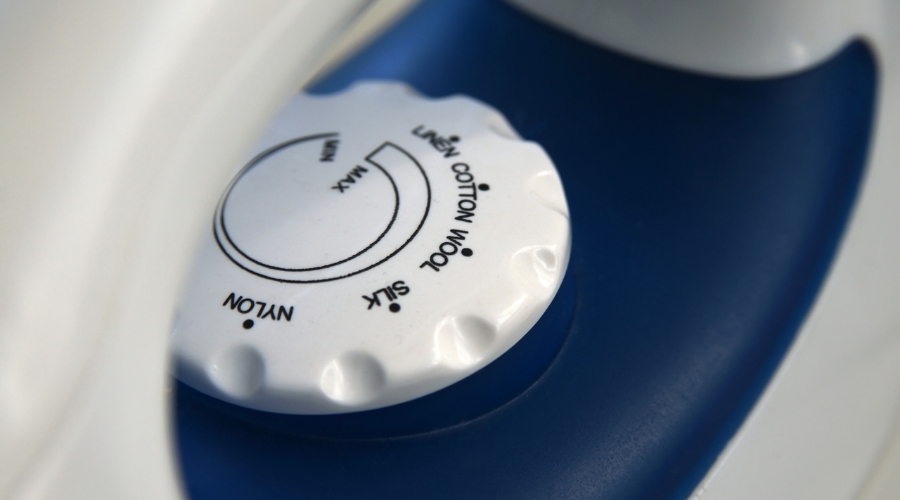Depending on the cloth, heating is usually done at a temperature of 180–220 °Celsius (356-428 °F). The optimum temperature setting for the type of fabric is perhaps the most important thing to learn before ironing garments or linens. Choosing the right iron setting might mean the difference between a great job and a disaster.
Iron Temperature Smart Guide
Ironing becomes easier, faster, and more professional with the appropriate temperature choices. However, if you use the improper temperature, you may have to work harder to remove creases or curled edges, or you may even burn a hole in your garment that cannot be mended.
Some irons have a sliding scale that shows the appropriate temperature setting for different fabrics. While the temperature settings on all irons vary slightly based on the manufacturer, use the guide below for proper temperatures for ironing various fabric types on a range of one to seven, one being cool and seven being very hot.
| Fabrics | Iron Setting | Ironing tips |
| Acetate | 1 | While the fabric is still wet, press it on the opposite side. |
| Acrylic | 3 | |
| Beaded | 1 | To avoid harming the beads, place the fabric on a fluffy white towel and press on the opposite side using a pressing cloth. |
| Cashmere | 3 | Instead of pressing, merely use steam. Use a pressing cloth on the opposite side to remove hard, set-in wrinkles. |
| Corduroy | 7 | Place the fabric on a fluffy white towel and iron it on the opposite side. To renew any crushed pile, turn the cloth over and use steam only on the front side. |
| Cotton(lightweight) | 5 | To avoid shine markings, iron dark colors on the opposite side of the fabric. |
| Cotton(heavyweight) | 7 | While the fabric is still a little wet, press it. To avoid shine markings on dark colors, only press the opposite side. |
| Damask | 5 | To avoid snagging lengthy strands, use a pressing cloth between the fabric and the iron. |
| Lace | 3 | To avoid snags and pulls, use a pressing cloth between the fabric and the iron. |
| Linen | 5 | For the best linen finish, iron on the opposite side of the wet fabric. |
| Nylon | 1 | Because nylon burns readily, always use a pressing cloth to protect the fabric from the iron. |
| Olefin | 3 | |
| Polyester | 3 | |
| Ramie | 3 | While the fabric is still damp, iron it on the opposite side. |
| Rayon | 3 | To avoid leaving a shine on rayon fabric, iron on the opposite side of the fabric. |
| Satin | 3 | With a pressing cloth between the iron and the fabric, press on the opposite side of the fabric. No steam should be used because it can cause water stains on the cloth. |
| Sequined fabric | 2 | Because sequins can melt if ironed, avoid doing so. To remove creases, lightly steam the opposite side of the fabric. |
| Silk | 3 | Press on the opposite side of the fabric. Steam should not be used since it can leave water marks on some silk materials. |
| Synthetic Blends | 3 | |
| Velvet | 3 | To erase wrinkles, it is best to steam rather than iron. If the creases are significant, place the cloth on a fluffy white towel and lightly press the opposite side of the fabric. To freshen the crushed pile after ironing, apply steam just on the front side of the fabric. |
| Woven Wool | 3 | Between the iron and the fabric, place a wet pressing cloth. To avoid snags and glossy marks, iron on the opposite side of the fabric. |
How to manage the temperature of your iron?
Separate your wrinkled clothing and linens by kind of fabric before you start ironing unless you’re just ironing a single outfit. Begin by ironing the items that require the least amount of heat, such as acetate and nylon. After that, go on to silks, polyester, and other synthetic materials such as olefin. Last but not least, iron cotton and linen materials.

Allow at least five minutes for your iron to cool down before using it again if you need to return to a lower iron temperature. You’ll be glad you took the time to do so!
Start low and iron on the opposite side of the fabric using a pressing cloth if you’re unsure what temperature to use. You can always progressively raise the temperature to remove tougher wrinkles while avoiding burning. Burn marks are difficult to erase, but they’re not always impossible if identified early and treated while they’re still light in color.
Iron Temperatures in Celsius and Fahrenheit
- Iron temperature for cotton
Cotton: 204 C/400 F - Iron temperature for polyester
Polyester: 148 C/300 F - Iron temperature for rayon
Rayon: 190 C/375 F - Iron temperature for silk
Silk: 148 C/300 F - Iron temperature for viscose
Viscose: 190 C/375 F - Iron temperature for wool
Wool: 148 C/300 F - Iron temperature for nylon
Nylon: 135 C/275 F
Iron Temperature for Patches
The standard iron temperature for patches is 350 degrees Fahrenheit. Before you start ironing anything onto your clothing, make sure you know what kind of fabric it is. Cotton, cotton blends, denim, and wool can all be ironed with patches.
Remember to iron on a flat surface for your safety. (see how to iron a patch here)
Iron Temperature for patches with steps:
- Preheat your iron to 350 degrees Fahrenheit (around five minutes or until hot) and place your patch on the fabric where you want it.
- Cover the patch with a pressed parchment square or a thin cloth. When ironing wool or other sensitive textiles, use a moist cloth. Also, make sure the towel is soaked rather than dripping wet.
- Apply firm pressure for around 30 seconds with your iron to the cloth on top of the patch. Allow five minutes for the material and patch to cool.
- Turn your clothing inside out and iron the area behind the patch for 30 seconds with firm pressure. This will guarantee that the patch is securely fastened. Allow another five minutes for the area to cool before continuing with the iron-on process.
Conclusion
One concluding tip, adjust the temperature to the right level and wait five minutes before ironing if you mistakenly miss a more delicate item after increasing the iron temperature. When you’re done, unplug the iron and set it aside to cool for at least 10 minutes before storing it.
Each type of fabric has different temperature settings for it to be ironed correctly. Otherwise, the fabric could be damaged or ruined. Check the label if you’re not sure what kind of fabric you have. You might even see instructions on whether or not the clothing can be ironed and at what temperature. If your label has iron symbols, remove them.
We hope this guide has been helpful to know which type of clothing needs what range of temperature settings.
